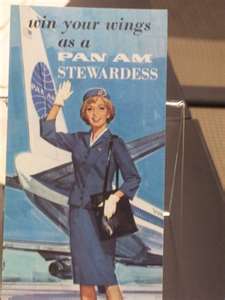Last night, my wife wanted to watch the new TV series Pan Am. I admit I did, too. My reason was simple and straightforward: I wanted to see the stewardesses. Well, I have to say they looked pretty damn good in HD. They looked just like Playboy bunnies, except the uniforms gave them an aura of bourgeois sanction.
Pan Am did provide a sense of how the period imbued jet travel with glamor and formality. That effect, including the upscale accommodations the crew enjoyed in London, was spot on. The premiere episode didn't go into the nuances of the first class cabin service, which in its day really tried to deliver a deluxe travel experience. That way of flying has largely vanished in the decades following the 1960s, when Pan Am is set.
I have some perspective on that time. When my family moved to New York, we lived in an apartment building known as a "stew zoo." In those days, flight attendants were female and were known as "stewardesses." Outside of presumed sexual availability, there was little that was "liberated" or "liberating" about being a "stew." My mom knew some stewardesses who lived next door to us. She became quite friendly with one who eventually became the survivor among her roommates. The stewardess's background fit the profile of her roommates, and from what we later learned, most stews.
My mom's friend, Judy, came from a small town. If she had attended college, it wasn't for long. She joined the airline (not Pan Am, by the way) so she could see the world and have adventures. She accomplished both goals, and eventually happily married a New York accountant whose client list included a high-profile name. However, the day-in, day-out stew life was a harsh grind, even for a very determined, very game Judy. She routinely had 4:00 am wake-up calls. She had to log eighty hours of flight time per month. Now, if you were on the glam Pan Am international routes, that schedule was manageable and even pleasant. If you were working domestic flights, it was a real drag. You worked hard, and you discovered very quickly that two hours and fifteen minutes in the air could be the longest two-fifteen in your life. And there's nowhere to hide at 33,000 feet.
Those conditions broke all of Judy's three roommates. Within six months, two of the roommates quit; the third didn't last much longer. That meant Judy was stuck paying the rent for an apartment which the original four stews could barely swing together. There were some grim days, including Judy living on (one) potato soup. My mom found out and fed her; Judy was proud, but also grateful for my mother's gesture. (For a time, Judy was like the daughter my mother never had.) My mom also looked in on Judy when she was sick. Illness was a stew's nightmare, as she would lose time and pay when she didn't work the cabins in the sky.
Judy gave us an insider's look at "glamorous" flying. We also had a passenger's perspective on it, courtesy of my father. My parents and I moved to New York, because my dad got a job with a petroleum company that involved extensive international travel. My father flew a lot, and he enjoyed it. My dad smoked in those days, and he would bring home monogrammed matches the airline gave him. (Those were the days when a first class ticket entitled the passenger to far more than today's free baggage allowances and inferior food.) Ironically, two of the better international airlines in that era were Pan Am and TWA. Both have been kaput for years -- except in the fantasyland known as the Fall 2011 television season.
Monday, September 26, 2011
The TV Show "Pan Am," "Stew Zoos," and the Golden Age of Passenger Jet Travel
Labels:
airline stewardess,
Pan Am,
Pan Am TV series,
Pan American Airways,
stew zoo,
TWA
Subscribe to:
Post Comments (Atom)











No comments:
Post a Comment